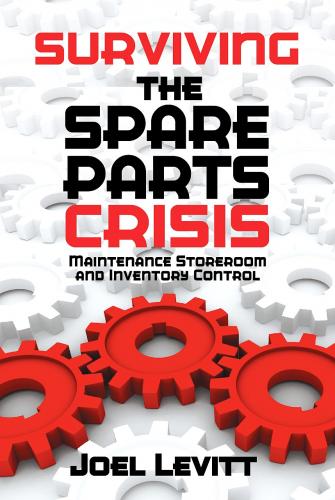How to Conduct a Physical Inventory
5S and Your Storeroom
Hoarding and Pirating of Inventory
12 The Economic Storeroom
Accounting for Spare Parts
Types of Demand
Different Models to Accommodate Demand
Carrying Costs
Economic Analysis: Big Ticket Analysis
Obsolete Parts and Gross Overstock
Managing Inventory Turns
The Call for Lean
How Service Level Contributes to the Spare Parts Crisis
Lead Time
Cost of Stocking or Procurement (Also Known as Cost of Acquisition)
13 SIC (Statistical Inventory Control)
Calculating Safety Stock
Economic Order Quantity (EOQ)
Additional SIC Formulas
14 Dealing with the Part Itself
Evaluation of Parts the First Time Around
Parts Interchange
Machine and Part Criticality
Warranty Recovery for Parts
Know Your ABCs: Segmenting Your Inventory for Analysis
Time to Failure
Reverse Engineering
Counterfeit Spare Parts
Cost of the Failure of Failure Analysis
15 Parts as a Business : E-MRO
The Internet and Savings
Maintenance Distributors
The Law: Uniform Commercial Code (UCC)
Vendors
Other Strategies
16 Parts: Replace-Rebuild-Remanufacture-Used
Replace
Rebuild
Remanufacture
Used
Remanufacture versus Replacement of Entire Machines
17 Metrics and KPIs for the Maintenance Warehouse
Performance Metrics
The SMART Technique
Why Measure?
Warehouse Metrics
Parts Metrics
Metrics for All of Maintenance
18 Bright Future for the Spares Business
Internet-Based Sourcing
3D Printing
Glossary
Bibliography
Index
INTRODUCTION
DID YOUR MANAGEMENT TELL YOU THAT “YOU ARE ALREADY A HERO”?
You are already cutting the inventory level before you even get started. Congratulations!
If you look at inflation in prices of parts over the last decade or two, you can see that parts prices have inflated faster than wholesale prices, consumer prices, or most other inflation metrics.
What that means is that bravely holding the line on the maintenance inventory is equivalent to a 5–10% annual decrease in inventory. That might not sound like a lot, but it does accumulate over time. Therefore, a $2 million inventory today is equal to a $1 million inventory just 10 or so years ago.
THE VOCABULARY OF STORES, STOREROOMS, PARTS WAREHOUSES, AND INVENTORY
Every field has words that mean special things. Although the jargon of a field can be (quite) challenging to outsiders, it allows practitioners to speak to each other quickly and accurately. The glossary in the Appendix provides a slew of definitions for the storeroom world’s special language. Understanding this special vocabulary is essential to understanding the field.
Note that for our purposes, the terms storeroom (stockroom, parts room) and warehouse (parts warehouse) are synonymous; they will be used interchangeably in this book to describe the parts storage location.
UNITS OF MEASURE
As you might imagine, the misuse of units of measure, at its worst, can create life-threatening problems. Suppose a Canadian airplane was refueled at a U.S. airport. The pilot asked for a certain number of kilograms of fuel but was given that number instead in pounds of fuel. That substitution could have been catastrophic. Generally, mistakes in unit of measure are embarrassing and sometimes expensive, but luckily not often catastrophic.
Common Unit of Measure
When stocking spare parts, the default unit of measure is the individual unit (or “each”). Products may be ordered and received in cases — for example, light bulbs — but they are stocked as individual units.
Unit of Issue
The unit of issue is a measure generally used to issue (or give out) an SKU (see below). For example, you might order and receive a case of bulbs, but the unit of issue would be each individual bulb. A challenge arises when you issue parts such as pipe, wire conduit, and steel plate, where the unit of issue is by itself not usually a problem, but maintaining the proper inventory count is. You store and issue light bulbs as complete units. No one requests half a bulb. However, with parts such as pipes, you may store them as complete sticks, but issue them in portions — 1/2 a stick of pipe or 1/4 sheet of steel plate.
When measuring your inventory, do not count partial quantities below the common unit of measure. For example, pipe is sold and issued in full lengths, so only count full lengths. It is likely that you have several short pieces; these are generally not counted. For other hard-to-count items, you should approximate (for example, lengths of wire, coiled tubing).
Stock Keeping Unit (SKU)
The stock keeping unit determines the base unit of measure. In the SAP system, which helps companies with inventory management, the term “base unit of measure” is more commonly used. For our purpose, the SKU is a single part number. If you have 200 SKUs, you have 200 different parts. However, you could have 20 of each part, or 4000 total parts.
Other Alternative Units of Measure
Alternative units of measure can also be defined to identify packages or larger containers for smaller units of measure such as cartons, boxes, bottles, barrels, pallets (storage unit types), and so on. The unit of measure has to be chosen for each item carried. Generally, the part master file in your Computerized Maintenance Management System (CMMS) or your enterprise resource planning (ERP) system carries a unit of issue and the unit purchased.
PREFACE
The entire maintenance spare parts business is in turmoil. There have been fundamental changes in the sale, distribution, and storage of spare parts needed to maintain machinery and other physical assets. In part, these changes have been caused by globalization with its increased competition. At the same time, the Internet has led to the disintermediation of parts distribution. Furthermore, advancements in technology in general have contributed to the rapid obsolescence of machinery, increasing the numbers of spare parts needed.
One factor that should
